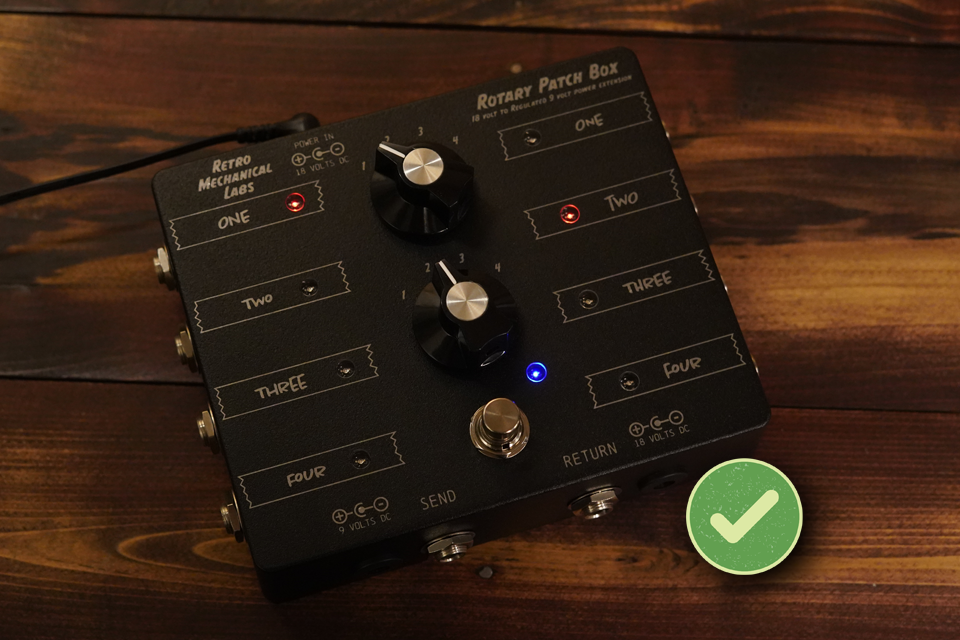Rotary Patch Box
**I’ve got a couple in stock but we can build more on demand if needed. Please allow 2-3 days for shipping if the few are sold.

Shipping: Free US Domestic
International Shipping: Varies on location but we cover half of the international shipping as a promotion to match our free domestic shipping.
**International shipping charges are estimated. We will invoice you for the shipping once we can determine the exact cost to your country. Feel free to message us with any questions.

Please Read:

I built this for myself. I’m constantly testing pedals for quality control before we send them out.
This requires a number of sound sources to test against. I often test our filter pedals with a wide open OSC from one of my Moogs, I use a DSI Pro2 to help with balancing meters, I patch in a guitar or bass for other situations. For monitoring sometimes I’m using my desk mixer. Sometimes I go directly to my UAD Apollo interface, sometimes guitar amps. Because of all that I’ve had a pile of cables and power supplies hanging over the side of my music desk.

So officially I present to you: The Rotary Patch Box or “RPB” for short. 4 ins / 4 outs with an effect send loop. A total of 10 patch points. Each connection is selected by 2 (4 position) rotary switches. LEDs indicate what you’ve selected.

This pedal requires an 18volt supply with a negative tip. An 18volt power supply will not only power the LEDs, but its DC output will be conditioned with a number of choice capacitors to help clean up any unwanted noise. I also regulate a perfect DC 9volt output. You can use both the 18volt and the 9 volt outputs at the same time. The amount of power you can deliver depends on the supply your using. I recommend the Dunlop ECB004. (Not included)
I’ll include a DC to DC extension cable to ship with this unit.

So how do I use mine? …I took the liberty of etchings my own labels as an example.
Quite possible the most useful box I own at the moment.
Here is a FAQ:
- Why do people need this? I see a lot of people with satellite gear sitting off to the side of their studio setups. This will not only limit the chaos of having multiple patch cables that need to be plugged and un plugged, it also helps keep things organized. Switching between sources and destinations is a breeze.
- Why is there a send/return on a stomp switch? I enjoy being able to experiment with pedals while recording music. This lets me send anything running through the RPB into an effects loop. It also provides a way to “hot swap” pedals without damaging my monitors. Simply bypass the effects loop and no more annoying pops and ground buzzes when changing pedals or guitars.
- Why not just use a patch bay? I Needed something more instantaneous. Studies show that if something takes longer than a a few seconds to set up the current generations looses interest and starts flipping through TikTok. I do have a patch bay too. But I don’t have a 19″ rack on the auxiliary side of the studio. One of the outputs of my RPB actually goes to that.
- Why not use a line mixer? Any powered device adds noise. I never record through a line mixer into my DAW. I always patch directly. Having my auxiliary instruments set up with a line mixer would mean unpatching them and then re-patching them into my DAW for a direct signal when needed.
- Is this MONO? Yes, I primarily use a lot of mono synths. I am considering making a stereo version. Let me know if thats something you’d like.
- What kind of electronics are in the audio path? NOTHING. Inside the box are direct mechanical connections. No buffers, no boosts. You don’t actually need to plug it in for the routing to work. A power supply only powers the LEDs and power extensions.
- Why is there “Power Extension”? When using pedals this provides a quick way to power them without having to set up different power supplies. I personally switch between 18volt and 9volt supplies constantly. By providing a regulated 9volt output I have eliminated one power adaptor from my mess on the floor.



The original concept design for the Rotary Patch box.

